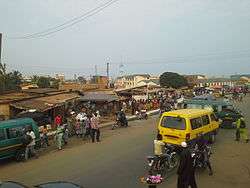Aflao
| Aflao | |
|---|---|
| Town | |
 | |
 Aflao Location in Ghana | |
| Coordinates: 06°08′48.4″N 01°10′47.6″E / 6.146778°N 1.179889°ECoordinates: 06°08′48.4″N 01°10′47.6″E / 6.146778°N 1.179889°E | |
| Country |
|
| Region |
|
| District | Ketu South District |
| Population (2012) | |
| • Total | 66,546[1] |
| Ranked 28th in Ghana | |
| Time zone | GMT |
| • Summer (DST) | GMT |
| Area code(s) | +233 (3625) |
Aflao is a town in Ketu South District in the Volta Region on Ghana's Togolese (eastern) border. Aflao is the twenty-eighth most populous settlement in Ghana, in terms of population, with a population of 66,546 people.[1]
In the 18th century, Aflao served as one of the major markets for the slave trade.
Geography
Aflao is located on the eastern coast of Ghana and is the major border town with neighboring Togo.
Chieftaincy
Aflao as a traditional area has Togbui Amenya Fiti V as her Paramount Chief.[2] He is the traditional ruler of the land and performs traditional administrative and ceremonial functions in the area.
Industry
The Diamond Cement Ghana Limited factory is located at Aflao.[3][4]
In early 2014, a 2.5 km rail siding was completed to connect the cement works to the port of Lomé.[5] This siding crosses the border from Togo to Ghana and is of the 1,000 mm (3 ft 3 3⁄8 in) gauge.
Notable people
- Joseph Kossivi Ahiator (1956-), artist
- Komla Dumor (1972 – 2014), journalist
- Ivan Srigboh-Afenu (1981-), Biometric and Security Expert
- [[Prof. Ernest Dumor] (), Educationist
- Ronald Y. Deku (1982 – 20--), Insurer
See also
References
- 1 2 "World Gazetteer online". World-gazetteer.com. Archived from the original on 2012-01-11.
- ↑ Togbui, Fiti. "Togbui Fiti Appeals For Gov't Intervention In Aflao Dispute". Spyghana. Retrieved 6 October 2014.
- ↑ "Production slumps at Diamond Cement". ghanaweb.com. Retrieved 26 February 2014.
- ↑ http://www.railpage.com.au/f-p1895531.htm#1895531
- ↑ Cement siding opened.
- Dickson, K. B. "Trade Patterns in Ghana at the Beginning of the Eighteenth Century." Geographical Review 56.3 (1966): 417-431.
External links
| Wikivoyage has a travel guide for Aflao. |

